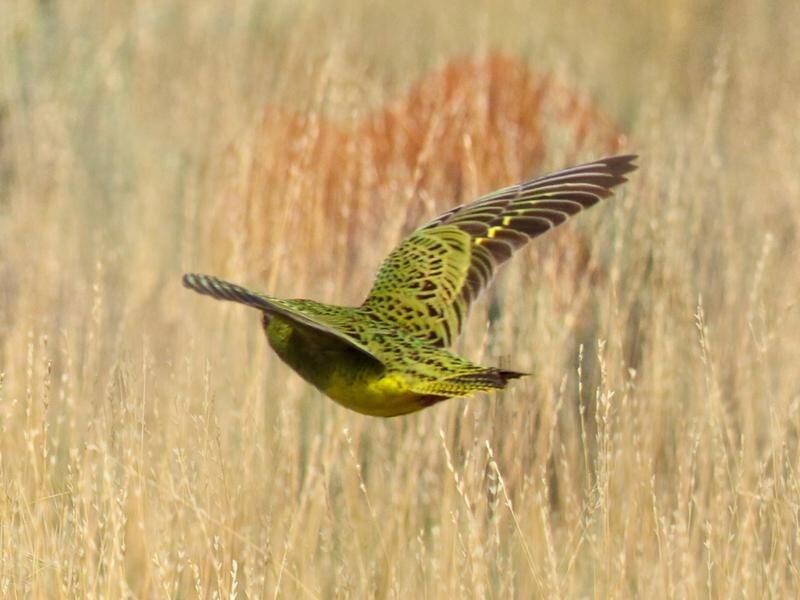
Aboriginal rangers could be critical to the survival of one of the world’s most elusive and endangered birds, the night parrot.
For a century the outback dweller was believed to be extinct until a naturalist took photographs of it in 2013.
First recorded in 1845, the last living specimen was collected in Western Australia in 1912.
It then disappeared, with no confirmed records of the bird between 1912 and 1979.
A trickle of fleeting but unconfirmed reports and two dead specimens found in Queensland in 1990 and 2006 added to the mystery.
Scientists say it has limited night vision but special cranial adaptations, including an asymmetrical skull and enlarged ears, which may give the critically endangered ground-dwelling parrot the edge it needs to make its way around the bush in the dark.
That the birds have actually survived is remarkable.
The evolutionary adaptations that make them so unusual – ground-dwelling, one of only two nocturnal parrots in the world, along with New Zealand’s kakapo – also make them extremely vulnerable to predation by feral cats.
And another big scourge of central Australia, the introduced buffel grass, out-competes the night parrot’s preferred habitat of spinifex, which also makes it highly susceptible to unmanaged wildfires.
A decade after the first official sighting, five Indigenous ranger groups have gathered at Bush Heritage’s Special Wildlife Reserve of Pullen Pullen in western Queensland to share knowledge about the parrot.
Only around eight to 10 night parrots are thought to nest on Pullen Pullen, however, ranger groups in WA have reported sightings and are attending the gathering.
Punmu ranger Neil Lane from central WA said the first time he saw a night parrot it made him happy.
“It’s good to come out here to see the different country and learn about night parrots and what they do and what they eat,” he said.
“I want to learn more about the night parrot’s world.”
The rangers and researchers try to attract night parrots by playing recorded calls from song meters housed in small cages left out overnight in the spinifex.
But again, introduced pest species are causing trouble.
“The camels keep bucking them sound recorders,” Mr Lane said.
The green, gold and black birds look a bit like large budgies and seem to need little water, hiding in clumps of spinifex by day and emerging after sunset to forage for food.
Without action to intervene and reduce the risks to the bird the future of this small population is precarious.
Bush Heritage ecologist Dr Nick Leseberg is working with the Indigenous ranger groups on protecting night parrots.
“The population here (at Pullen Pullen) is relatively small but where the birds are being found in Western Australia is across a much larger area and they’re being found on Indigenous land,” he said.
“The future of the night parrot rests in all our hands but rangers are going to be a really important part of it because they’re going to have more night parrots on their country than just about anywhere else.”
The gathering, which was facilitated by Bush Heritage, included representatives from the Indigenous Desert Alliance, the Department of Climate Change, Energy, the Environment and Water, and the Central Land Council, Warlpiri Ranger, Kiwirkurra Ranger, Ngururrpa Ranger and Punmu Ranger groups.
Ngururrpa Ranger Clifford Sunfly, who is based in Balgo, WA, saw his first night parrot in 2021.
“I heard the wings and the flapping sound and the outline of it through the stars flying across,” he said.
“I was tapping my grandfather, telling him not to make a sound and he just put his phone down, looked around and then coughed.
“And then it took off and I told him, ‘if you would’ve been quiet you would’ve heard it whistle’.”
Mr Sunfly said by the rangers from different areas getting together they could share their knowledge.
“We are all slowly learning together about the behaviour of the night parrot and where it’s going, where it’s eating and how to protect it,” he said.
“It’s because of this place where they first found a night parrot that it all started.
“Then we found out there were night parrots out there in WA and we started our ranger group, and first started to look for night parrots.
“It’s better working together because we can all let other rangers know … and share tips and advice to protect country and protect the night parrot.”
Pullen Pullen Reserve on Maiawali Country, five hours from Longreach, was purchased by Bush Heritage in 2016 to protect the night parrot’s critical habitat.
In 2020, the Queensland Government declared Pullen Pullen the state’s first special wildlife reserve, which provides the 56,000 hectare site with the same protection as a national park.
Australian Associated Press
